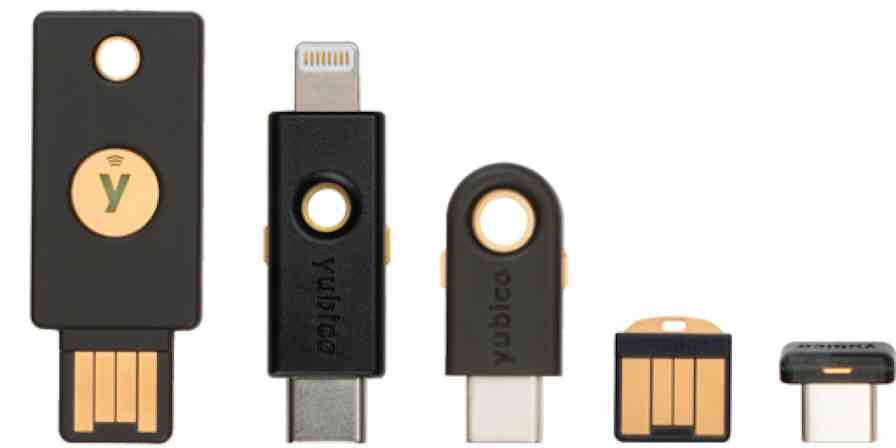At Zapier, everything revolves around app integrations. Since June 2012, we've done 312 app integrations and with over 40 of those coming in the past two months alone, there's no sign we're slowing down.
The reason for our app integration madness: Zapier is an app automation platform. Users visit Zapier to make two apps talk to each other without writing a line of code, and companies add their app to the platform to instantly integrate it with hundreds of other apps (often without a line of code, too).
With each app integration, comes one question from new partners: What's the best way to market the Zapier integration? Early on, we ran experiments, but over time we've put a process behind the madness, letting us reply to this constant question with answers backed by success.
It all goes back to a document, our , we put in place last October when we had around 250 apps on Zapier. Now 60 app integration launches later, we have even more experience and experiments to share.

The following tactics are what have work best when launching a new app integration on Zapier. Hopefully sharing our lessons learned helps you get the most out marketing your next app integration.
1. Understand the Objective of the Integration
We're in a unique position at Zapier since we're an app integration hub, but even with that in mind, we approach each integration with the same priority: Make Zapier better for our customers. We've learned that Zapier is only valuable when the apps our customer use—all of them—are connected to the platform.
For you, keeping current customers happy should be a priority, too. So if there's a request for an app integration, the objective to integrate is apparent. But app integrations have become popular for another objective, too: growth hacking.
"When you integrate with a successful product that already has a substantial user base, you tap into that market and get your product in front of them. That’s a huge audience you’ll gain access to," says Lars Lofgren on the Kissmetrics blog, dispensing knowledge shared in a presentation by the company's co-founder, Hiten Shah. But he follows that up with an important instruction: "Don’t integrate for the sake of integrating. Look for integrations that will add more value for your customers."
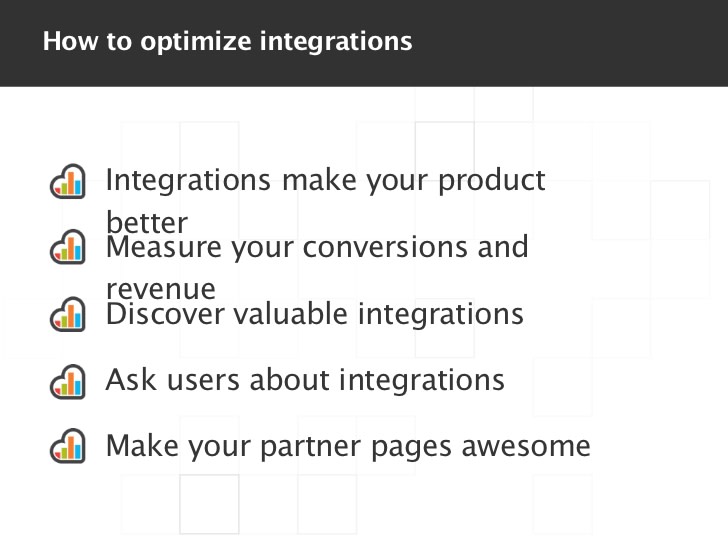
Other objectives for an integration include a boost in credibility—especially if you can initiate co-marketing activity with a reputable company—and a test of a feature before full implementation. But whatever your objective, make sure its clear up front and lay out the metrics, such as new customers or number of actions in your app, you'll use to gauge its success. App integrations can become distraction to your tech team and ultimately your business.
2. Identify the Partner's Key Customer Benefit
No matter the objective, the company initiating the integration should ask their new partner how integrating their app will benefit the partner's customers. As is often the case in startups: your assumptions will likely be false.

This was the case when we integrated with Disqus, one of the most popular commenting platforms. From our point of view, Zapier's best asset was its ability to beef up comment notifications for Disqus admins, adding the ability to stream comments to a group chat app (how the integration), team email address or mobile push notification app. But when I jumped on a phone call with Ro Gupta, vice president of business development at Disqus, he wondered if Zapier could integrate Disqus with customer support software like Desk, a request they had gathered from customers. Of course we can! When it came time to market the integration, that example was one of two Zapier-Disqus integrations Ro shared on the Disqus blog:
In doing so, they cooked up some cool ways to trigger an action on a new Disqus comment or flag, e.g. backing comments up to Google docs, being notified of a keyword mention in chat apps like Slack or sending key comments to help desk systems like Desk.
3. Be Specific with Marketing Requests
As mentioned above, when an app integration launch is around the corner, the new partner asks us: What's the best way to market this new integration? When I started the Zapier marketing position in August, I would reply with a hodgepodge of co-marketing ideas, from tweeting about the integration to including it in their next email newsletter.
Today, we make specific asks and partners either go for it or turn us down, but there's no mystery in what we think would be the best way to market this new integration. Here are some of those asks:
Publish a blog post with a link to their partner page on Zapier (e.g. the Disqus integrations page)
Share their and our blog post across social channels
Email their users about the Zapier integration
When we integrated with Slack in February, for example, we asked for all of the above but the only applicable marketing channel for early stage startup was to share on Twitter. They did so:
'28 apps in 28 days' https://t.co/XjKpQpenA8 • @Zapier is adding a new app/service every day in February. Honored that Slack was first up!
— Slack (@SlackHQ) February 3, 2014
And continued to do so:
Use @zapier to hook things into Slack? The integration has been upgraded to enable link expansion (off by default) & custom avatars per zap!
— Slack (@SlackHQ) February 20, 2014
4. Secure a Partner Page and Make It Look Pretty
Another request to add to your checklist is to get your app listed on the partner's integration directory, which can also be called a partner page, app directory, app store, app marketplace or a handful of other names. The goal here is to solidify exposure past launch, making sure the partner's users are able to discover what your integration has to offer.
With this in mind, make sure to peruse their integration directory before submitting the copy and art for your partner page. Look at the top apps and study what makes them stand out, how they tailored their copy and art to fit the particular directory. Don't hesitate to ask the partner for any listing suggestions, too, along with inquiring how apps are ordered, featured or ranked in the directory—it could be by votes, reviews or simply alphabetically or most recently added.

Integration directories vary drastically in design and app feature methods, such is the case with (from top left) Trello, MailChimp, Asana and Nimble.
Two more partner page tips:
Before making the request to be added to their site, add a partner page for their app first (even if a private link, show the marketing will be reciprocated)
Be proactive and ask your users who start using the integration to leave a rating on your listing in the partner's app directory.
5. Offer to Write Copy, Including a Guest Post
Asking a new partner for a blog post, social media sharing, user email and a partner page can be overwhelming for the marketer at the company. So to ease their decision-making process and workload, offer to do it for them: write the blog post, suggest tweets, offer email copy and complete the partner page application. It may sound time-consuming, but it speeds up and streamlines the process.
Here's my checklist following a co-marketing call with feedly, the popular reader app we integrated earlier this month.
Zapier to-do
- Author announcement (guest post) for feedly blog - Author announcement for Zapier Updates Blog - Author guest post "5 Ways to Use Feedly with Zapier" - Send interview questions for feedly profile on main Zapier blog
Feedly To-Do
- Keep an eye out for interview questions
As the instigator of the integration—we added feedly based on popular user demand—we had the lion's share of tasks. But it paid off. The feedly launch followed all of our best practices (and more: see No. 8) and became one of our most successful co-marketing campaigns to date.
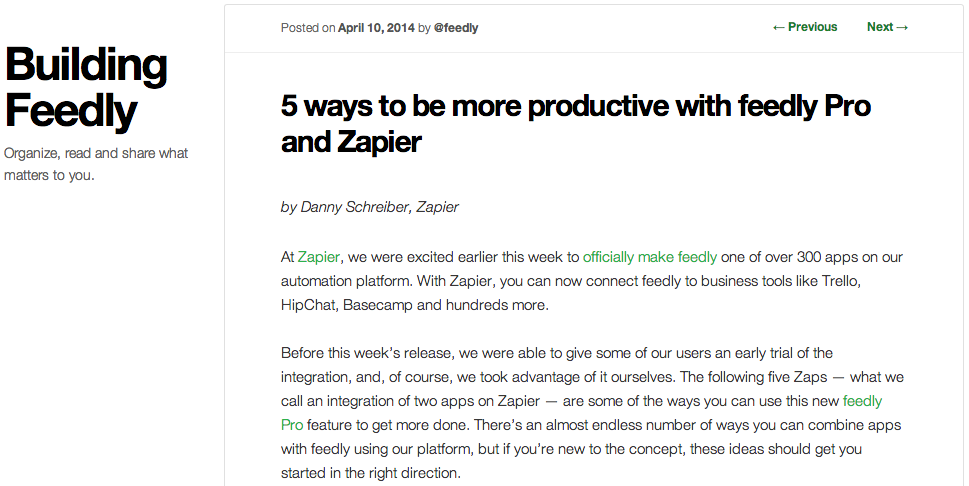
6. Ask for In-App Messaging, Email to Users
Thanks to a great start to our partner relationship with feedly, we were exposed to another high-return co-marketing activity: in-app messaging announcing the integration. This didn't take any clever copy or a fancy graphic, just a their standard in-app messaging sharing the Zapier integration news.
Here's what it looked like:

Another effective co-marketing practice is to either be the focus of an email sent to all users or featured within a company newsletter, the former is much preferred. In our co-marketing guide, we go so far as to offer sample copy for such an email.
7. Reciprocate All Co-Marketing Activity
This tip might be buried at No. 7, but if you're reading this whole post you're deserved of this golden nugget: it's important to reciprocate all partner co-marketing activity. In other words, it's a lot easier to ask a lot from a partner when you are going to do a lot in return. This was the top piece of co-marketing advice shared by Zapier CEO Wade Foster, who led up our app integration launch marketing before I joined the team.
Whether it's a blog post, tweet or email to users, make sure you're prepared and have the capacity to put in the co-marketing efforts, as well.
8. Provide Art Assets
We recently put a format in place for images on guest blog posts for launches, using the plus sign between the two apps. For example: Todoist + Zapier. This makes sure our brand is well represented and gives the partner another piece of content to share on social media. After all, tweets with images, Buffer's Courtney Seiter shared from company research, received 18 percent more clicks, 89 percent more favorites and 150 percent more retweets.
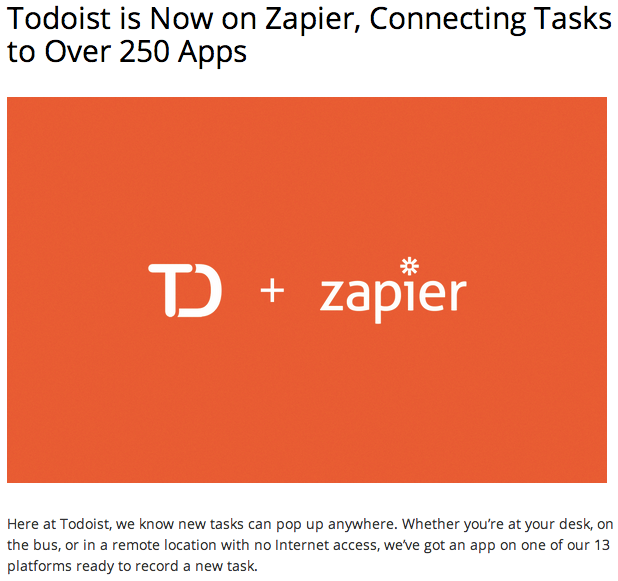
9. Outline Your Process, Offer Examples
One of the best practices we've implemented at Zapier is wrapping up all of the above and more into a partner-focused guide we call our Partner Co-Marketing Guide. This has everything from Zapier testimonials at the start to ongoing co-marketing suggestions to close it out.
The best part of this co-marketing guide, however, isn't the lists of what we think our partners should do, but examples of what's worked well for past partner launches. We include examples from well-known companies such as WooThemes, Survey Monkey and Asana.
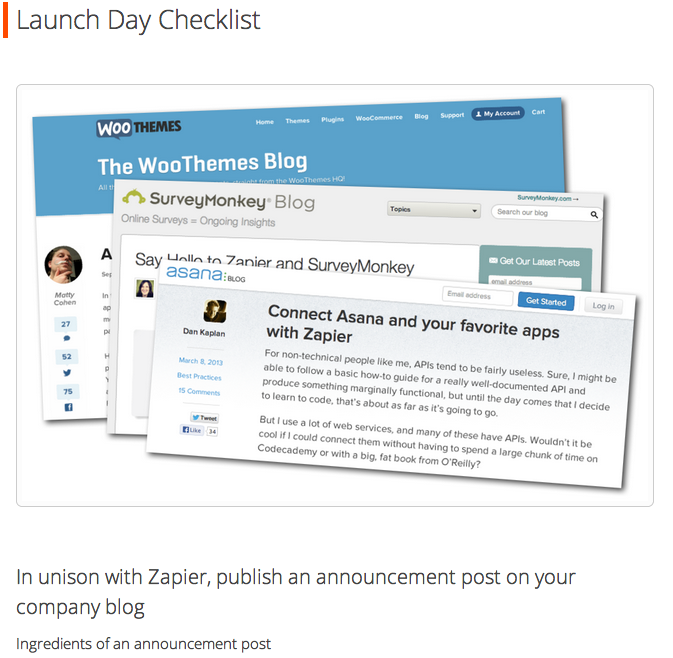
Typically, an email conversation with a new partner starts out with links to this document. Here's a snippet pulled from an email thread in my inbox:
For a quick breakdown of how we do co-marketing, here's an outline from our side: . We've also put together a suggested launch outline for partners, too: .
10. Record Metrics, Log Best Practices
As mentioned in the Objectives section above, before launch make sure you've identify the metrics you'll be able to measure to gauge if the integration meets its objective. At Zapier, we track how many of our current users are making use of the app, how many users signed up to take advantage of the new app and how many integrations are live (users can have more than one integration per app), among other data points. We're also able to segment how much each integration accounts in our overall revenue by noting how many paying users are taking advantage of the app.
"If you find an audience that’s a good fit, focus more energy on making that integration even more awesome," Kissmetrics' Lar Lofgren encourages.
If your metrics don't point to a successful integration, however, the next step is to examine whether more marketing or a different marketing approach is needed, or very likely, the integration itself isn't necessary. Once again, your assumptions could be false.
11. Follow-Up Post-Launch
Immediately after launch, I'll send the new partner links to our blog post and initial tweet. This helps kick start the social sharing of the announcement and offers another point to suggest further co-marketing or ask again for a tactic you were hoping to implement.
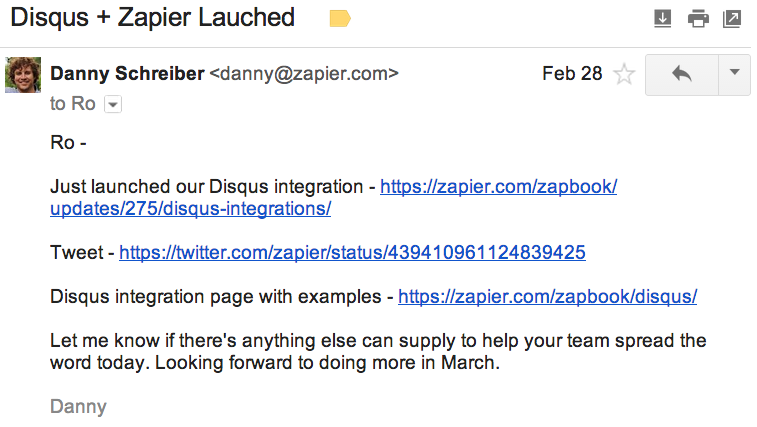
We have plans to include a short survey in this follow up email to continue improving our partner relations on top of looking at the success metrics we've identified. (If you're doing this now with valuable feedback being gathered, it would be awesome to hear more your survey in the comments below.)
12. Find Ways to Continue Co-Marketing
One easily overlooked benefit of an integration is the long-term co-marketing potential—the weeks of launch prep with a partner often leave you with a foundation for a strong personal relationship. I've found that teaming up with another marketer to execute a launch makes for the start of a collaborative relationship, where we've gone onto execute other co-marketing activities. Mainly, it's been in the form of guest posting, such as we were able to do on the Unbounce blog, but there are other possibilities.
In our Partner Co-Marketing Guide, we offer 14 potential co-marketing activities, listing them by time commitment and noting the marketing channel. Here are those activities:
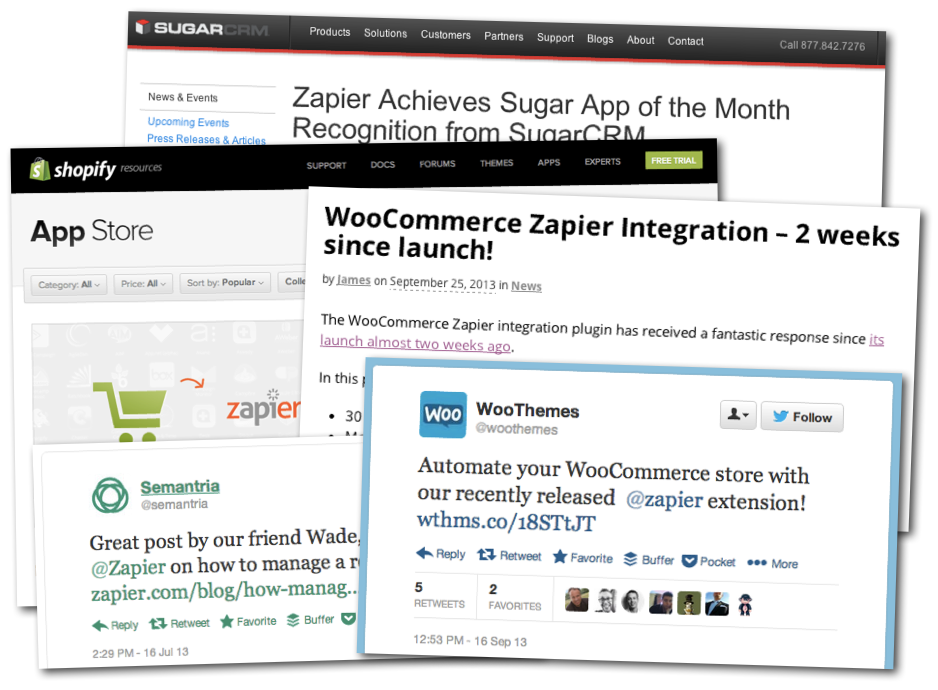
Quick and Easy
Share specific Zaps (integrations) (social media)
Promote each other’s content (social media)
Notify your users of cool and popular use cases via Zap Template links (email newsletter)
Feature the Zapier integration in your app store (integrations directory)
Small Time Commitment and Effort
Highlight users’ cool use cases via video, audio or text (email newsletter, blog)
Provide updates, such as new features of your app that integrate with Zapier, via the Zapier Updates Blog and Newsletter (email newsletter, blog)
Review each other’s apps (blog)
Medium Time Commitment and Effort
Write a tutorial for your site or a third-party site (blog)
Author guest posts for each other's blogs (blog)
Team up and pitch Zapier integration success stories and unique use cases to beat writers, industry or niche outlets (private communications)
Large Time Commitment and Effort
Compose case studies on impactful use cases of Zapier integration (blog, marketing page)
Conduct webinars on specific use cases (blog, email newsletter)
Interview execs/founders/feet-on-the-street via video, audio or text (blog)
What's Worked Best for You?
This is just a start. Other tactics we've found effective include adding Zapier to the new partner's FAQ or Support Docs (we do the same on our side) and including Zapier in the onboarding process, two recommendations we make in our Partner Co-Marketing Guide.

Six months into ramping up our efforts around partner co-marketing, these are some of the biggest lessons we've learned. What tactics have worked best from your experience? We'd love to learn about them in the comments below.
Credits: Top beaker glass photo courtesy Horia Varlan. Bottom beaker glass photo courtesy William Frankhouser.


